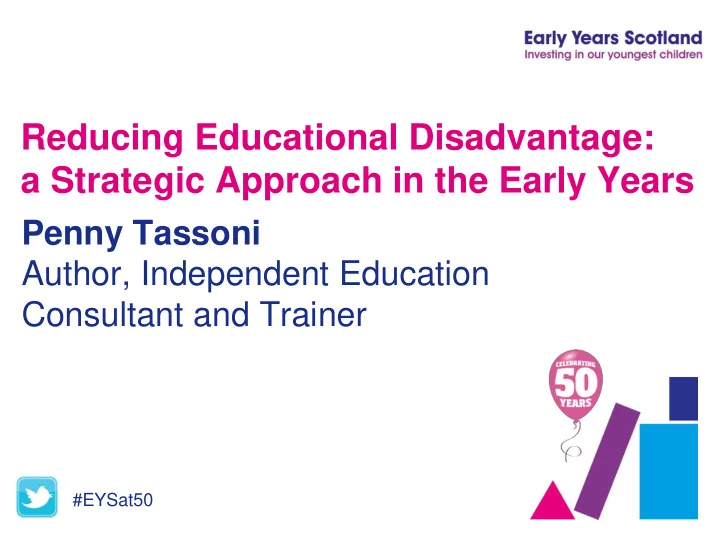

Reducing Educational Disadvantage: a Strategic Approach in the Early Years Penny Tassoni Author, Independent Education Consultant and Trainer #EYSat50
The Background Poverty has multiple, negative impacts on children’s outcomes leading to inequalities in health, cognitive development, psychosocial development and educational attainment. These inequalities are evident from preschool children through children during the school years, from entry into the labour market to resources for retirement, from mortality rates in later life, and often on to the next generation Impacts of poverty on children and young people Morag C. Treanor
Social mobility? Children who perform highly in ability tests in early childhood who are from low socio- economic backgrounds are repeatedly overtaken in ability tests carried out in later childhood by children from higher socioeconomic backgrounds who had performed less well in the early years Impacts of poverty on children and young people Morag C. Treanor
Lucky children have… Strong relationships and time with adults Opportunities to interact Opportunities to share books Varied experiences/ adult directed activities Challenging play opportunities
Starting Points Most practitioners want to make an active difference to children’s lives It is important to recognise children at risk of educational disadvantage early on Parents are a central part of this journey Precise assessment is an important tool to work more strategically
Relationships Secure key person relationships affect children’s willingness to communicate and engage with new activities Good settling in systems are essential to supporting children and their families It is also important to monitor the depth of children’s relationship with key adults in the setting
The Power of Language Language changes the way that children process and store information Language changes the way that children play Good levels of language are associated with learning to read Language is essential for writing Lower levels of language are associated with poor behaviour and difficulties in concentration
Why language matters… By 22 months – a child’s language development can predict outcomes at age 26 By ages 3-6 years - a child’s narrative skills are a powerful predictor of literacy skill at 8-12 years By 4 years – the difference in the number of words children from disadvantaged backgrounds hear is 19 million By 5 years – a child’s vocabulary will predict their educational success and outcomes at age 30. Early language: Facts and Stats, ICAN, August 2014
Interaction Matters? Consider how many and the length of average interactions for children in your setting Monitor those children who are not forthcoming and may not seek out interaction Think about how you assess developing language
Stories What are the benefits of a 1:1 story? Could this become an essential part of an educational programme? Could you develop tracking systems to support children’s progress? Do you have sufficient high quality books?
Experiences Different experiences build children’s language and vocabulary They can enrich children’s play What kind of experiences do you plan for children? e.g. cooking, posting a letter, gardening Do you have a long term plan for such experiences?
Rhymes Rhymes support children’s phonological awareness How many rhymes will children in your setting know when they leave? How do you track these? How are they planned and shared with parents?
Mathematical Games A range of games can help children’s concepts and skills Is there a planned approach to ensure that children are learning through games such as picture lotto, snap or pairs Are more challenging roll-a-dice games introduced?
Recommend
More recommend